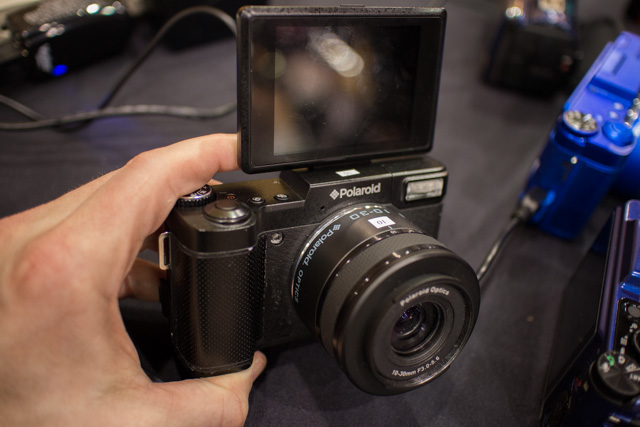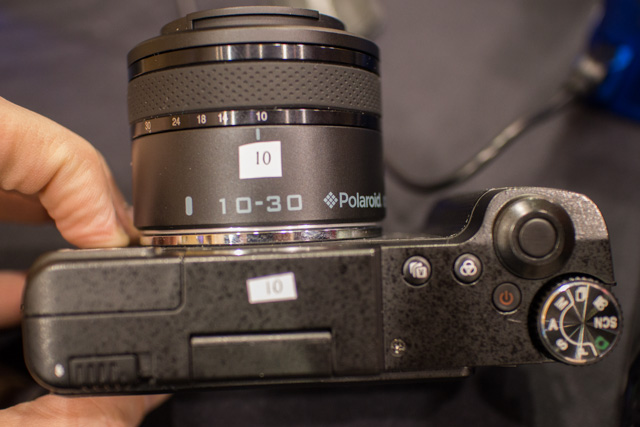
Polaroid’s new mirrorless cameras were on display at CES 2013. The previously-leaked iM1836 Android-powered camera finally surfaced along with two other, non-Android models – the iM1232W (featuring built-in WiFi) and iM1030.
Based on the lens focal lengths and zoom ranges, the chances are good that we’re looking at a 1″ sensor (akin to the Sony RX100 and Nikon 1 J3) inside the complete line of Polaroid mirrorless cameras. I couldn’t get a Polaroid rep to confirm this; however, there’s really no other sensor size that works for the lenses shown on these cameras.

As I began to question the Polaroid rep concerning the cameras’ construction and features, he was quick to point out they these cameras are targeted at a different audience than more mainstream prosumer mirrorless cameras from companies like Sony, Olympus and Nikon.
Instead, these models will likely find their place at just above the typical Walgreens digital camera shopper. Or, perhaps we’ll see them on QVC or the like.

The prototypes feel very cheap and plastic. While they may look like Nikon’s 1 series cameras in shape and size, they very much feel a step or two below in the quality department.

Here’s the craziest thing about the Polaroid models though – the sensor is in the lens.
Sound familiar? Remember Ricoh tried (is still trying?) a similar approach with its GR-series.
For whatever reason though, Polaroid included a mock sensor in the camera, which is simply a piece of reflective plastic that sort of looks like an image sensor.

Why? The only clear reason I could get was for aesthetics.

The only functional hardware between the lens and the camera body are the pins that transmit data between the lens/sensor and controls on the camera body.

Circling back to the initial target audience issue… The design is so confusing – particularly given the placement of a “fake” sensor in the camera body. Why even bother making this camera/lens unit into separate components? If a camera manufacturer is going to try to scrape the bottom of the consumer market with a “mirrorless” camera, are they seriously thinking that their “system” is going to move multiple lens/sensor units in this market?

Unless Polaroid really comes out with something previously unseen in this new mirrorless line that proves special in terms of features or image quality, these cameras are almost certainly destined to fail. The Polaroid mirrorless camera lineup wins out as the weirdest camera I saw at CES 2013.
These cameras should hit stores in the first quarter of 2013.



















While I am not interested in these Polaroid cameras or the Ricoh ones, I am intrigued by the idea of having the sensor built into the lens. Think of how much more you would be willing to change your lens if you didn’t have to worry about dust getting on the sensor?
Like you pointed out the target market for this camera is not likely to be wanting extra lenses. This camera does not make much sense. The ones by Ricoh are equally baffling as the change the sensor specs in each lens.
Does the idea of sensors built into the lens interest anyone else or is it just me?
I guess this camera is likely to catch those who would be impressed by a pricewise Android gadget that also comes with camera.
I think of my wifes friends and young boys, in an emerging economy it may make more sense than we thought
My 2 cents
Also, think about workflow. really.
We grew up having to perform separate tasks to close the loop in the workflow, shoot, transfer, retouch/process, classify/tag, and print/publish/share/store/backup.
Youngsters are growing with almost 90% of the workflow being native on their phones, so this Android camera (picewise) offers this.